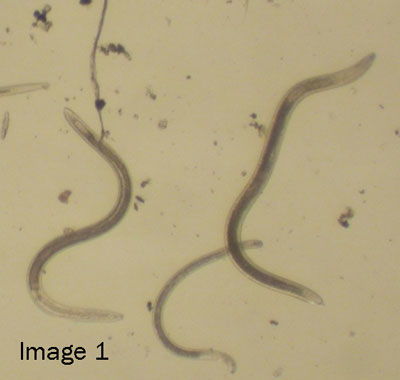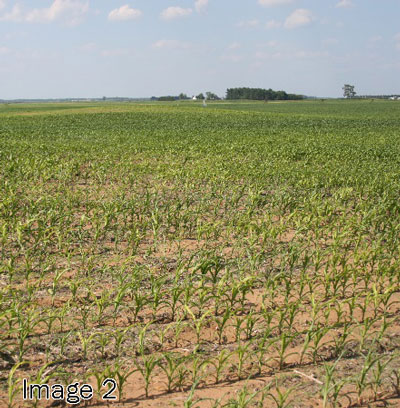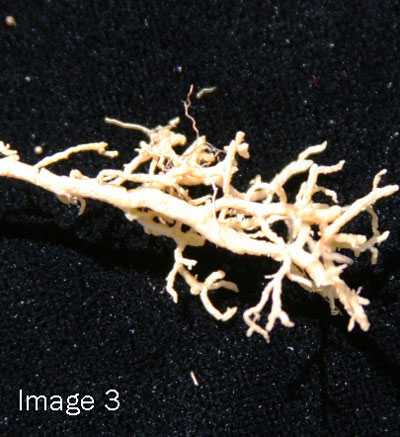
- Corn nematodes are neglected pests that may be skimming bushels from corn yields.
- Parasitic corn nematodes make up just a fraction of the total soil nematode population.
- Careful sampling is required to detect and confirm presence of plant parasitic nematodes.
Nematode Background
In the thin, biological layer of the Earth's surface, nematodes really are almost everywhere. Some of these nematodes are pests, some are beneficial, and many are just part of the general makeup of the ecosystem. When we focus on corn, nematodes are nearly everywhere in corn fields too. In this environment, a varying percentage of the nematodes are plant parasitic, versus scavengers or beneficial. (Some nematodes feed on bacteria or fungi, and some on other soil organisms.) Most of these nematodes are not new pests, but have been present for centuries as part of the prairie and grass ecosystem. Corn is just one more grass to feed upon. So, if we are to be completely accurate, we should refer to "nematodes in corn," instead of "corn nematodes."
Recent studies have revealed that parasitic corn nematodes are much more common than we have previously thought. In one regional survey of 727 counties in 16 states, 99 percent of the samples contained plant parasitic nematodes. Focusing on just one major nematode, 81 percent of the samples contained root lesion nematodes. These samples were not biased toward sandy soils, although sandy soils tend to have higher population levels of other plant-parasitic nematodes.
Damage
It has been speculated that changing tillage practices, changes in other cultural practices, and reduction in use of some soil insecticides may have contributed to rising corn nematode populations. Specifically, an elimination of use of certain organo-phosphate and carbamate soil insecticides (Counter, Furadan, Mocap), a reduction in tillage, use of grass or small grain cover crops, and an increase in corn-on-corn acreage all are suspected of contributing to higher corn nematode populations, or at least a possible increase in damage from the nematodes.
Nematode species, like sting or needle nematodes, pose a high risk of economic damage. Stubby root, lance, and lesion nematodes pose a moderate risk, and spiral, stunt, and dagger nematodes pose a low or undetermined risk. The nematode risk level is a combination of different factors, including method of feeding, feeding site, plant response, numbers of nematodes, frequency of occurrence, etc. For example, the sting nematode is highly damaging to corn because it feeds at root tips and injects a toxic substance during feeding. So, it takes very few sting nematodes to stunt and inhibit growth of the corn root system.
Detection
Where nematodes are suspected as a source of corn yield loss, soil samples must be taken to aid in the diagnosis. Plant parasitic nematodes are microscopic (cannot be seen with the naked eye). Understand that failure to detect corn nematodes in soil samples does not rule out the possibility of nematode damage. Nematode populations are notoriously clumped or aggregated in fields, and may be missed with random sampling patterns. Successful nematode sampling will provide indication of parasitic species present and the relative population level of those species.
The corn late vegetative growth period is a good time to sample for corn nematodes. However, certain species, such as needle nematodes, may not show up in these samples because of their ability to move deeper in the soil as it gets hot and dry. For needle nematodes, samples should be taken within six weeks of corn planting.
Corn Nematode Sampling Procedure
- Next to the corn row, use a soil probe to take samples through the root system to a depth of 8 to 12 inches. Include root tissue in the sample.
- When targeting areas of fields with visual damage, sample at edges of damaged areas, not in the middle.
- Take multiple, random samples from the field.
- Include several root systems or portions of root systems in the final sample. These are necessary to assess the number of "endoparasitic" nematodes.
- Thoroughly, but GENTLY, mix soil cores and submit a subsample of about a quart of soil in a plastic bag. Mark bags clearly.
- Keep samples cool and ship for rapid delivery. Avoid shipping over weekends when samples may sit in the post office or warehouse.
- Submit thorough, complete, accurate information with the sample.
Management
Effective corn nematode management requires a holistic approach where all facets of the system are examined and managed toward the goal of long term optimization of economic corn production. Where corn nematodes are suspected to be at damaging levels, the place to start is with soil samples to determine nematode species and population levels. Management efforts should include crop rotation to non-susceptible host crops, tillage (where appropriate), building the soil to optimum-to-high fertility levels, use of the granular insecticide, Counter, and/or use of Avicta®Complete Corn, Poncho®/VOTiVO™or other corn seed treatments. Management of water through irrigation seems like it should be one of the management efforts, although some nematode species appear to thrive under crop irrigation.
Contact your FS Crop Specialist for your agronomic information.


Image 1: Microscopic View of Plant Parasitic Nematodes
Image 2: Area of Field Showing Nematode Damage
Image 3: Corn Root Damage from Nematodes